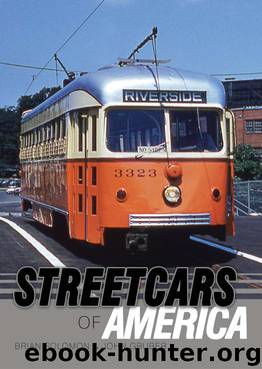Streetcars of America by Brian Solomon John Gruber

Author:Brian Solomon,John Gruber
Language: eng
Format: epub
Tags: Streetcars of America
ISBN: 9780747815242
Publisher: Random House Publisher Services
Chicago Transit Authority PCC car 7111 captured downtown near State and Harrison in about 1953. At its peak, Chicago had 683 PCCs, with cars built by both St. Louis and Pullman.
Chicago Transit Authority operated the city’s surface lines in the final years of trolleys. After abandonment of the streetcar services, many of Chicago’s PCCs were rebuilt for rapid transit on the “L”—elevated rapid transit. This view was exposed in March 1958 not long before surface-line operations ended for good.
Chicago, like New York City, embraced rapid transit early, and its overhead “L” (for “elevated”) developed as primary urban conduits. Initially the “L”s were steam powered, using fleets of diminutive Forney-type tank locomotives to haul trains above the streets. The “L”s began electrifying in the 1890s and became best known for a complete circuit through downtown—universally known as “The Loop,” which was actually so-named for the cable-car loops that predated the “L.” As a result the surface lines evolved as feeders to the “L”s and other railway lines.
Some Chicago surface lines were exceptionally long, while a flat fare of 7 cents allowed passengers a one-way journey anywhere on the network. Yet, the average passenger only rode the cars for relatively short distances. In 1916, an extensive route-by-route analysis of the surface lines revealed that on many routes average journeys were between 1.6 and 2.7 miles, while on downtown lines at least 30 percent of passengers traveled no more than 1 mile and less than 10 percent of surface-lines riders traveled more than 6 miles.
As with most city streetcar systems, bus conversion began before the Great Depression. After World War II, the Chicago Transit Authority assumed operation of the surface lines and in the 1950s, CTA rapidly converted remaining lines to rubber tire transport. The Clark Street route held out until 1958. Since CTA’s PCCs were still relatively new, many were transformed into rapid transit cars and continued to serve for decades.
In addition to its surface lines, Chicago was also served by interurban electric lines; most famous were the three Samuel Insull systems; Chicago North Shore & Milwaukee, Chicago South Shore & South Bend, and Chicago, Aurora & Elgin. The North Shore and CA&E both benefited from direct access to downtown over the “L” system that Insull also controlled, while South Shore used Illinois Central’s electrified line to Randolph Street. In addition to high-speed intercity trains to Milwaukee, North Shore provided local streetcar services to several communities along its line, including Waukegan, Illinois (until 1947) and Milwaukee, Wisconsin (until 1951). From the 1920s, local streetcar services were operated with single-truck Birney cars, which contrasted with its heavy interurban electrics.
In the early 1940s, North Shore bought a pair of modern articulated streamliners, which it dubbed “Electroliners.” These were among the most impressive electrics to ever grace American streets, and until 1963 worked Milwaukee street trackage as part of a direct downtown to downtown service to the Chicago Loop. After North Shore folded, these were bought by Philadelphia’s Red Arrow Lines for third-rail electric service to Norristown.
Download
This site does not store any files on its server. We only index and link to content provided by other sites. Please contact the content providers to delete copyright contents if any and email us, we'll remove relevant links or contents immediately.
| Automotive | Engineering |
| Transportation |
Small Unmanned Fixed-wing Aircraft Design by Andrew J. Keane Andras Sobester James P. Scanlan & András Sóbester & James P. Scanlan(32574)
Navigation and Map Reading by K Andrew(4889)
Endurance: Shackleton's Incredible Voyage by Alfred Lansing(4506)
And the Band Played On by Randy Shilts(2014)
Wild Ride by Adam Lashinsky(1870)
The Box by Marc Levinson(1863)
Top 10 Prague (EYEWITNESS TOP 10 TRAVEL GUIDES) by DK(1851)
The Race for Hitler's X-Planes: Britain's 1945 Mission to Capture Secret Luftwaffe Technology by John Christopher(1741)
The One Percenter Encyclopedia by Bill Hayes(1717)
Trans-Siberian Railway by Lonely Planet(1629)
Girls Auto Clinic Glove Box Guide by Patrice Banks(1620)
Looking for a Ship by John McPhee(1573)
Batavia's Graveyard by Mike Dash(1549)
TWA 800 by Jack Cashill(1523)
Fighting Hitler's Jets: The Extraordinary Story of the American Airmen Who Beat the Luftwaffe and Defeated Nazi Germany by Robert F. Dorr(1517)
Troubleshooting and Repair of Diesel Engines by Paul Dempsey(1498)
Good with Words by Patrick Barry(1496)
Bligh by Rob Mundle(1489)
Ticket to Ride by Tom Chesshyre(1479)
